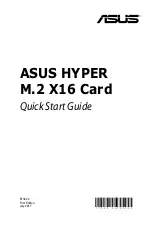
PulseBlasterESR-PRO
Timing Characteristics
The PulseBlaster core's timing controller accepts an external (on-board) crystal oscillator of 50 MHz.
The input frequency is internally multiplied. The PulseBlasterESR-PRO is available with 4 different
internal clock frequencies: 250 MHz, 300 MHz, 400 MHz, and 500 MHz. The innovative architecture of
the timing controller allows the processing of either simple timing instructions (with delays of up to 2
32
clock cycles or 8.59 s at 500 MHz), or double-length timing instructions (up to 2
52
clock cycles long – over
100 days at 500 MHz!). Regardless of the type of timing instruction, the timing resolution remains
constant for any delay – just one clock period (e.g., 2 ns at 500 MHz).
The PulseBlaster core-timing controller has a very short minimum instruction time – only five clock
periods
. This translates to a 10 ns machine instruction time at 500 MHz. The PulseBlasterESR-PRO is
also capable of generating pulses on all outputs of lengths down to one clock cycle. For more information
on this feature, please see the
Instruction Set
The PulseBlaster core features a set of instructions for creating highly flexible pulse program flow
control. The micro-programmed controller allows for programs to include branches, subroutines, and
loops at up to 8 nested levels – all this to assist the user in creating dense pulse programs that cycle
through repetitious events, especially useful in numerous multidimensional spectroscopy and imaging
applications.
External Triggering
The PulseBlasterESR-PRO can be triggered and/or reset externally via dedicated hardware lines.
The two separate lines combine the convenience of triggering (e.g., in cardiac gating) with the safety of
the "stop/reset" line (firmware-dependent). The input pins for the trigger and reset are pulled to logical-
high on the board and can be activated by a low-voltage pulse (short to ground).
Summary
The PulseBlasterESR-PRO is a versatile, high-performance pulse/pattern TTL signal generator
operating at speeds of up to 500 MHz and capable of generating pulses ranging from 2 ns to 104 days
per instruction at intervals ranging from 10 ns to 8.59 s per instruction (using a 500 MHz clock signal). It
can accommodate pulse programs with highly flexible control commands of up to 4096 instruction words.
Its high-current output logic bits are independently controlled with an unterminated output voltage of 3.3 V.
1
NOTE: For PulseBlasterESR-PRO-500 design 17-11, instructions with CONTINE, JSR, RTS and LONG_DELAY OpCodes, require a
minimum instruction time of at least 6 clock-cycles (12.0 ns). For PulseBlasterESR-PRO-400 design 9-18, the minimum instruction time
is 7 clock-cycles (17.5 ns).
2019/09/26








































